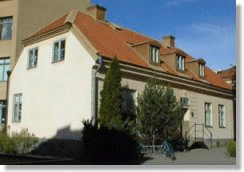Hospital Records for the County Hospital of Östergötland 1838–1895
Go directly to the search page (Swedish only)
In Sweden in the middle ages it was the church which supplied medical care either through hospitals or helgeandshus.
In Östergötland, there were two middle age’s hospitals: one in
Skänninge, which started in 1268 and one in Söderköping, which started
in 1277. The first appearance of a helgeanshus in Östergötland is in
1330 in Söderköping. Others followed in Skänninge, 1331, Linköping,
1342 and Vadstena, 1401. There was a large increase in the number of
hospitals in the 18th and 19th centuries. Most often, hospitals ended
up with “impossible cases” but avoided social outcasts such as
prostitutes and alcoholics. In the modern sense, there were no
hospitals until the beginning of the 19th century. Before 1750, medical
care was usually financed by charitable organizations, church, or
guilds.
The term hospital was reserved for those places that provided care
for the mentally ill. From the end of the 19th century, these were
referred to as “sinnessjukhus” and in the 20th century as mental
hospitals. Hospitals treating venereal diseases were called “kurhus”.
The health councils were started in 1862 with the new law that gave
municipalities the possibility to work together to create collective
health councils. Östergötland created a health council including all
its municipalities. In 1862, Östergötland had four hospitals: in
Norrköping, Linköping, Söderköping and Vadstena. Finspång and Kisa got
medical care in the 1870s. In 1872, however, Norrköping left the
Östergötland’s Health Council and did not rejoin until 1967 (for which
reason, hospital records from between 1872 and 1966 can be found in
Norrköping’s archive).

The County Hospital as it looks today
The first provincial hospital was built in Östergötland in 1777 in
Linköping. The hospital was built on the original medieval hospital’s
site. The building is still present, squeezed between modern apartment
buildings. A permanent hospital was opened in 1848 in the old military
barracks.
The hospital has different fees for different patients depending
upon their personal wealth, and correspondingly different care levels.
As an example, in 1896, first-class treatment cost 75 öre per day while
second-class treatment was 40 öre. Private rooms cost between three
and five crowns and two-person room cost between 1.5 and 2 crowns per
day.
A new hospital was opened in September, 1895, an extension epidemic
sicknesses was built in 1910 and another for tuberculosis in 1929
(which became the central hospital building later). A children’s unit
was added in 1930, the result of a donation from the Östergötland’s
Children Union. After a state decision in 1960, the central hospital
became a regional hospital and in 1971 the main block was built. Today
research and medical training are conducted at the University Hospital.
The first students were admitted in 1986, with the first graduations in
1992.
The database contains 22 170 records with information about:
- Admission date
- Identity number
- Profession
- Name (divided into given names and family names)
- Gender
- Birth date
- Age (year, month, day)
- Residence
- Class (self paying or not)
- Room number
- Illness (the name of the illnes: the name of the illness is missing between 1886–1895)
- Admission number
- Health state upon discharge (four categories: healthy, improved, incurable or dead)
- Notations
The county hospital records cover the period 1838–1895, volumes G4a:1–34. Hospital records are hospital patient’s care notes.
The transcription from the original tomes to the on-line
databases has maintained the notation, spelling, etc. of the original
documents. The exception is that dates have been written in the modern
style, to be more compatible with on-line searching. All transcription
was done directly from the originals and the Region Archive of Östergötland, supplied all the fines
registers. ArkivData in Norrköping have carried out digitalization of
the originals.
Region Archive of Östergötland, Hospital Records for the County Hospital of Östergötland , 1838–1895, volumes G4a:1–34. Linköping University Electronic Press, https://doi.org/10.3384/db.sjukhus
Ahnlund, Hans-Olof och Hallqvist, Lars. Norrköpings lasarett 200 år. Från curhus till länssjukhus. En jubileumsskrift. Linköping: Östra hälso- och sjukvårdsdistriktet, Östergötlands läns landsting, 1985.
Hellström, Sven (red.). Linköpings historia, del 3, Tiden 1567–1862. Samhällsliv och kulturliv. Linköping: Kommittén för Linköpings historia, 1976.
Hellström, Sven (red.). Linköpings historia, del 4, Tiden 1863–1910. Linköping: Kommittén för Linköpings historia, 1978.
Johannisson, Karin. Medicinens öga. Sjukdom, medicin och samhälle – historiska erfarenheter. Stockholm: Norstedt, 1990.
Nilsson, Hans (red.). Norrköpings historia. 1900-tal. Linköping: Centrum för lokalhistoria, Linköpings universitet, 2000.
Olofsson, Lars. Det lilla lasarettet mitt i stan. Länslasarett i Linköping 1782–1895. Linköping 1989
Olofsson, Lars. Från länslasarett till regionsjukhus. Länslasarettet i Linköping 1895–1960, del 2. Linköping 1994.
Schött, Harald. Östergötlands läns landsting 1863–1912. Linköping 1921.